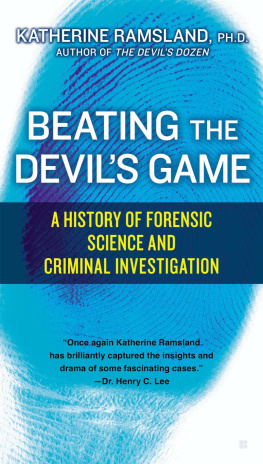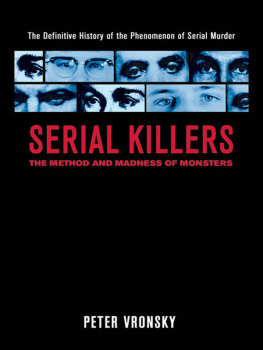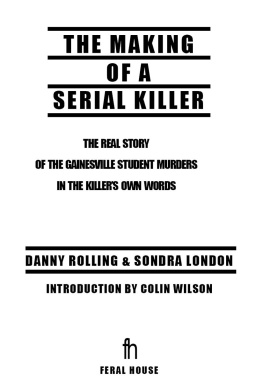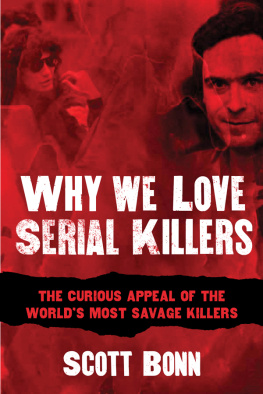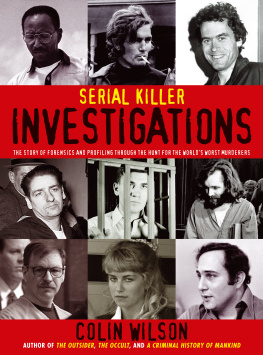I wish to thank those who have involved me in digging deep into the minds of serial killers, which helped me over the years to gain the expertise needed for this book. Marilyn Bardsley got me started, and several FBI profilers gave me access to their thinking about cases: John Douglas, Roy Hazelwood, Gregg McCrary, Bob Ressler, and Mark Safarik. Others whove helped me think through my work include Sally Keglovits, Dana DeVito, Rachael Bell, my Dangerous Minds students, Al Carlisle, Susan and Zachary Lysek, Dan Wisniewski, Bob Keppel, Bob Hare, and even Dennis BTK Rader, with whom I spent five years exploring his life story.
Im also grateful to my long-time agent John Silbersack and my editors, John Meils and Stefan Dziemianowicz, who trusted my sense of this intense subject and encouraged my progress.
INTRODUCTION
The literature of serial murder is full of fascinating tales about how killers were caught. I once analyzed 300 cases for identification and arrest detailsand identified more than a dozen distinct variables that played a key role in their capture. I learned that the largest number of successful resolutions (one in five) involved conscientiouseven extraordinaryinvestigation. The killers own errors mostly tripped them up after that, and a few even turned themselves in. The survey included different historic eras and countries (though mostly the U.S.), and I chose cases that offered clear details regarding identification and capture (so it was not a randomized sample). Still, it provided a lens through which I saw how incredibly difficult it can be for investigators to sort through evidence (or decry the lack of it) and identify productive leads.
And while there are many steps in any investigation, especially those that last for years, even decades, one or more specific but common factors usually lead to the key break in a case. These are:
- Police investigation, including physical evidence/crime-scene behavior
- Witnesss description (including survivors)
- Accomplices betrayal
- Associates suspicions (friend, neighbor, relative)
- Arrest during an unrelated police operation
- Killed a victim that was easily linked to them
- Killers communication to press, victims, or police
- Stored evidence (at home, on person, in computer, or in storage)
- Error at a crime scene linked to other scenes associated with a suspect
- Caught in the act
- Turned themselves in
- Recognized from published likeness
- Common factor in multiple cases
- Postmortem investigation (often after suicide)
From this list, I created five categories for this book:
- Forensic Innovation
- Police Procedure
- Mistakes and Miscalculations
- Witness Reports
- Self-Surrender
The cases were then selected based on their notoriety, diversity, and teaching value. Those linked to a significant forensic contribution are probably the most instructive, since they revisit forensic history and could inspire future innovations. Still other cases were drawn from underrepresented populations, which might help to erode misconceptions about who commits serial murder. And a few are simply classic crime narratives. Although this collection is by no means exhaustivethousands of serial-murder cases have been documentedit represents the variety of serial killers with which law enforcement must contend. Hopefully, these cases will also inspire some appreciation for the magnitude of their task and the lives they save when captures are made.
I should note that there are several myths associated with serial killers, thanks largely to misinformation or sensationalism from various media sources. Chief among them is the persistent notion that most serial killers wish to be caught. In fact, its listed among the myths the FBI hoped to correct in their monograph from more than ten years ago, Serial Murder: Multi-Disciplinary Perspectives for Investigators. In my own survey, only 2.3 percent of serial killers turned themselves in (at times merely due to a lack of options). So while some criminologists believe that a subconscious desire to be caught leads to mistakes that end in arrest, only about 20 percent of serial killers in my study made such errors. Even if we stretch the notion to include as a subconsciously motivated desire being charged with another crime first, adding this 12.3 percent to overt mistake-makers (20.3 percent) and those who surrender on their own (2.3 percent) still equals just one in three who want to be caught. This myth appears to be built on the belief that we all have a conscience, but psychopathic predators have repeatedly shown that they experience little to no remorse. Even some who turned themselves in were not at all repentant about their murders.
This collection of cases demonstrates a historic arc from basic detective work to sophisticated forensic innovation. The phenomenon of serial murder weaves throughout the history of forensic science and psychology as the most challenging type of crime. However, improved resources over the past few decades help to identify these offenders more quickly. In addition, detectives now can return to former investigations with new tools, closing cases that had seemed unlikely to ever be solved. The stories told here affirm the positive evolution of serial-murder investigations and will hopefully inspire further forensic innovation.
PART I
FORENSIC INNOVATION
Some cases of serial murder inspired investigative innovation, while others benefited from it. Often, it took a meeting of the minds between scientists and investigators to recognize the possibilities, and some innovations significantly transformed crime-scene investigation.
1.
THE MAD CARPENTER
THE CRIMES
Two young girls went missing in the small village of Lechtingen, Germany, in 1898. Hannelore Heidemann was seven, and her friend and neighbor Else Lanmeier was just a year older. They often walked home from school together, but neither arrived home on September 9. The worried mothers traveled together to the school to find them, only to learn that neither girl had arrived at school that day. A search of the local woods ensued. Neighbors pitched in. The girls families were frantic. They asked everyone they knew, but no one recalled seeing either girl that day. And nothing turned up in the woods where the girls often played to indicate that theyd been there. It wasnt like either of them to skip school or worry their parents. As evening approached, it seemed possible that they would remain lost until morning, though several people kept looking.





